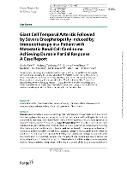| dc.contributor.author | Fiala, Ondřej | |
| dc.contributor.author | Tkadlecová, Michaela | |
| dc.contributor.author | Pivovarčíková, Kristýna | |
| dc.contributor.author | Baxa, Jan | |
| dc.contributor.author | Stránský, Petr | |
| dc.contributor.author | Šiková, Dominika | |
| dc.contributor.author | Hora, Milan | |
| dc.contributor.author | Fínek, Jindřich | |
| dc.date.accessioned | 2024-10-02T11:15:36Z | |
| dc.date.available | 2024-10-02T11:15:36Z | |
| dc.date.issued | 2024 | |
| dc.identifier.uri | https://hdl.handle.net/20.500.14178/2640 | |
| dc.description.abstract | Introduction: Combined immuno-oncology (IO) regimens are the cornerstone of the current front-line systemic therapy for metastatic renal cell carcinoma (mRCC). Despite the fact that combined IO regimens show high efficacy, they are often accompanied by a wide spectrum of immune-related adverse effects (irAEs). Case Presentation: We describe a case of rare irAEs manifested as giant cell temporal arteritis (GCA) followed by severe encephalopathy occurring after continuing immunotherapy in a 66-year-old man with mRCC receiving a combination of ipilimumab and nivolumab in the first line of systemic therapy. GCA occurred 4 months after the initiation of IO and responded promptly to the low-dose prednisone therapy. Four months after the continuation of nivolumab maintenance, the patient was hospitalized due to severe irAE encephalopathy which presented as psycho-behavioral abnormalities and progressive cognitive decline. He was treated with high-dose methylprednisolone which led to complete resolution of the symptoms and IO was permanently discontinued. The patient achieved a durable partial response. Conclusion: Both GCA and the subsequent encephalopathy in our patient responded well to the corticosteroid therapy, leading to the complete resolution of the symptoms and the patient achieved a durable partial response. Although the risk of severe neurologic irAEs affecting the central nervous system induced by IO re-administration, following previous discontinuation due to irAE, is not well-defined because of their rarity, this case highlights the need for caution, particularly in cases with a history of previous irAE-associated GCA. | en |
| dc.language.iso | en | |
| dc.relation.url | https://doi.org/10.1159/000540660 | |
| dc.rights | Creative Commons Uveďte původ-Neužívejte dílo komerčně 4.0 International | cs |
| dc.rights | Creative Commons Attribution-NonCommercial 4.0 International | en |
| dc.title | Giant Cell Temporal Arteritis Followed by Severe Encephalopathy Induced by Immunotherapy in a Patient with Metastatic Renal Cell Carcinoma Achieving Durable Partial Response: A Case Report | en |
| dcterms.accessRights | openAccess | |
| dcterms.license | https://creativecommons.org/licenses/by-nc/4.0/legalcode | |
| dc.date.updated | 2024-10-22T20:47:27Z | |
| dc.subject.keyword | Encephalopathy | en |
| dc.subject.keyword | Giant cell arteritis | en |
| dc.subject.keyword | Immune-related adverse effects | en |
| dc.subject.keyword | Immune-related adverse events | en |
| dc.subject.keyword | Immunotherapy | en |
| dc.subject.keyword | Nivolumab | en |
| dc.subject.keyword | Renal cell carcinoma | en |
| dc.identifier.eissn | 1662-6575 | |
| dc.relation.fundingReference | info:eu-repo/grantAgreement/MSM//LX22NPO5102 | |
| dc.relation.fundingReference | info:eu-repo/grantAgreement/EU/FP8/856620 | |
| dc.relation.fundingReference | info:eu-repo/grantAgreement/UK/COOP/COOP | |
| dc.relation.fundingReference | info:eu-repo/grantAgreement/FN/I-FN/I-FNP-10 | |
| dc.date.embargoStartDate | 2024-10-22 | |
| dc.type.obd | 73 | |
| dc.type.version | info:eu-repo/semantics/publishedVersion | |
| dc.identifier.doi | 10.1159/000540660 | |
| dc.identifier.utWos | 001316217400001 | |
| dc.identifier.eidScopus | 2-s2.0-85203055920 | |
| dc.identifier.obd | 651923 | |
| dc.subject.rivPrimary | 30000::30200::30204 | |
| dcterms.isPartOf.name | Case Reports in Oncology | |
| dcterms.isPartOf.issn | 1662-6575 | |
| dcterms.isPartOf.journalYear | 2024 | |
| dcterms.isPartOf.journalVolume | 17 | |
| dcterms.isPartOf.journalIssue | 1 | |
| uk.faculty.primaryId | 111 | |
| uk.faculty.primaryName | Lékařská fakulta v Plzni | cs |
| uk.faculty.primaryName | Faculty of Medicine in Pilsen | en |
| uk.faculty.secondaryId | 54 | |
| uk.faculty.secondaryName | Fakultní nemocnice Plzeň | cs |
| uk.faculty.secondaryName | University Hospital in Pilsen | en |
| uk.department.primaryId | 1425 | |
| uk.department.primaryName | Onkologická a radioterapeutická klinika | cs |
| uk.department.primaryName | Department of Oncology and Radiotherapeutics | en |
| uk.department.secondaryId | 100012968318 | |
| uk.department.secondaryId | 5000002711 | |
| uk.department.secondaryId | 5000002733 | |
| uk.department.secondaryId | 5000002725 | |
| uk.department.secondaryId | 1361 | |
| uk.department.secondaryId | 1434 | |
| uk.department.secondaryId | 1439 | |
| uk.department.secondaryName | Biomedicínské centrum | cs |
| uk.department.secondaryName | Biomedical Center | en |
| uk.department.secondaryName | Klinika zobrazovacích metod | cs |
| uk.department.secondaryName | Klinika zobrazovacích metod | en |
| uk.department.secondaryName | Urologická klinika | cs |
| uk.department.secondaryName | Department of Urology | en |
| uk.department.secondaryName | Onkologická a radioterapeutická klinika | cs |
| uk.department.secondaryName | Department of Oncology and Radiotherapy | en |
| uk.department.secondaryName | Šiklův ústav patologie | cs |
| uk.department.secondaryName | Department of Pathology | en |
| uk.department.secondaryName | Klinika zobrazovacích metod | cs |
| uk.department.secondaryName | Department of Imaging Methods | en |
| uk.department.secondaryName | Urologická klinika | cs |
| uk.department.secondaryName | Department of Urology | en |
| dc.description.pageRange | 921-927 | |
| dc.type.obdHierarchyCs | ČLÁNEK V ČASOPISU::článek v časopisu::kazuistika | cs |
| dc.type.obdHierarchyEn | JOURNAL ARTICLE::journal article::casuistics | en |
| dc.type.obdHierarchyCode | 73::152::202 | en |
| uk.displayTitle | Giant Cell Temporal Arteritis Followed by Severe Encephalopathy Induced by Immunotherapy in a Patient with Metastatic Renal Cell Carcinoma Achieving Durable Partial Response: A Case Report | en |

